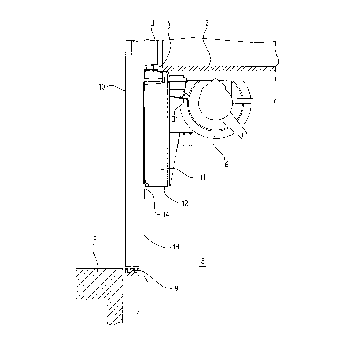Une partie des informations de ce site Web a été fournie par des sources externes. Le gouvernement du Canada n'assume aucune responsabilité concernant la précision, l'actualité ou la fiabilité des informations fournies par les sources externes. Les utilisateurs qui désirent employer cette information devraient consulter directement la source des informations. Le contenu fourni par les sources externes n'est pas assujetti aux exigences sur les langues officielles, la protection des renseignements personnels et l'accessibilité.
L'apparition de différences dans le texte et l'image des Revendications et de l'Abrégé dépend du moment auquel le document est publié. Les textes des Revendications et de l'Abrégé sont affichés :
| (12) Demande de brevet: | (11) CA 2234333 |
|---|---|
| (54) Titre français: | ASCENSEUR AVEC BOITE DE COMMANDE |
| (54) Titre anglais: | LIFT WITH CONTROL BOX |
| Statut: | Réputée abandonnée et au-delà du délai pour le rétablissement - en attente de la réponse à l’avis de communication rejetée |
| (51) Classification internationale des brevets (CIB): |
|
|---|---|
| (72) Inventeurs : |
|
| (73) Titulaires : |
|
| (71) Demandeurs : |
|
| (74) Agent: | RICHES, MCKENZIE & HERBERT LLP |
| (74) Co-agent: | |
| (45) Délivré: | |
| (22) Date de dépôt: | 1998-04-08 |
| (41) Mise à la disponibilité du public: | 1998-10-11 |
| Licence disponible: | S.O. |
| Cédé au domaine public: | S.O. |
| (25) Langue des documents déposés: | Anglais |
| Traité de coopération en matière de brevets (PCT): | Non |
|---|
| (30) Données de priorité de la demande: | ||||||
|---|---|---|---|---|---|---|
|
Ascenseur avec système de commande monté sur la cabine et dont la boîte de commande (11) est placée au-dessus ou au-dessous de la porte de la cabine (3). Grâce à l'invention, le technicien qui fait la maintenance a facilement accès aux composantes électriques de l'ascenseur, notamment les limiteurs de fin de course, circuits de sécurité, dispositifs de commande optionnels, inverseur de fréquence et autres, lesquelles se trouvent commodément situées à hauteur de la main ou des yeux sur un palier d'étage (5) quand les portes de la gaine (10) sont ouvertes.
Lift with drive system which is mounted at the cage and the control box (11) of which is
arranged above or below the cage door (3). Through the invention it is made possible for
the service engineer to reach the electrical components of the lift, such as travel
regulation, safety circuits, optional drive regulation, frequency inverter, etc., conveniently
standing at hand or eye level at a storey floor (5) with the shaft doors (10) opened.
Note : Les revendications sont présentées dans la langue officielle dans laquelle elles ont été soumises.
Note : Les descriptions sont présentées dans la langue officielle dans laquelle elles ont été soumises.

2024-08-01 : Dans le cadre de la transition vers les Brevets de nouvelle génération (BNG), la base de données sur les brevets canadiens (BDBC) contient désormais un Historique d'événement plus détaillé, qui reproduit le Journal des événements de notre nouvelle solution interne.
Veuillez noter que les événements débutant par « Inactive : » se réfèrent à des événements qui ne sont plus utilisés dans notre nouvelle solution interne.
Pour une meilleure compréhension de l'état de la demande ou brevet qui figure sur cette page, la rubrique Mise en garde , et les descriptions de Brevet , Historique d'événement , Taxes périodiques et Historique des paiements devraient être consultées.
| Description | Date |
|---|---|
| Inactive : CIB de MCD | 2006-03-12 |
| Inactive : CIB de MCD | 2006-03-12 |
| Le délai pour l'annulation est expiré | 2004-04-08 |
| Demande non rétablie avant l'échéance | 2004-04-08 |
| Réputée abandonnée - omission de répondre à un avis sur les taxes pour le maintien en état | 2003-04-08 |
| Inactive : Abandon.-RE+surtaxe impayées-Corr envoyée | 2003-04-08 |
| Demande publiée (accessible au public) | 1998-10-11 |
| Inactive : CIB en 1re position | 1998-08-06 |
| Inactive : CIB attribuée | 1998-08-06 |
| Symbole de classement modifié | 1998-08-06 |
| Inactive : Certificat de dépôt - Sans RE (Anglais) | 1998-06-17 |
| Demande reçue - nationale ordinaire | 1998-06-16 |
| Date d'abandonnement | Raison | Date de rétablissement |
|---|---|---|
| 2003-04-08 |
Le dernier paiement a été reçu le 2002-03-27
Avis : Si le paiement en totalité n'a pas été reçu au plus tard à la date indiquée, une taxe supplémentaire peut être imposée, soit une des taxes suivantes :
Les taxes sur les brevets sont ajustées au 1er janvier de chaque année. Les montants ci-dessus sont les montants actuels s'ils sont reçus au plus tard le 31 décembre de l'année en cours.
Veuillez vous référer à la page web des
taxes sur les brevets
de l'OPIC pour voir tous les montants actuels des taxes.
| Type de taxes | Anniversaire | Échéance | Date payée |
|---|---|---|---|
| Enregistrement d'un document | 1998-04-08 | ||
| Taxe pour le dépôt - générale | 1998-04-08 | ||
| TM (demande, 2e anniv.) - générale | 02 | 2000-04-10 | 2000-03-27 |
| TM (demande, 3e anniv.) - générale | 03 | 2001-04-09 | 2001-03-22 |
| TM (demande, 4e anniv.) - générale | 04 | 2002-04-08 | 2002-03-27 |
Les titulaires actuels et antérieures au dossier sont affichés en ordre alphabétique.
| Titulaires actuels au dossier |
|---|
| INVENTIO AG |
| Titulaires antérieures au dossier |
|---|
| CHRISTOPH LIEBETRAU |
| KASPAR SCHINDLER |
| UTZ RICHTER |